Warning- Some photos may depict the circle of life...
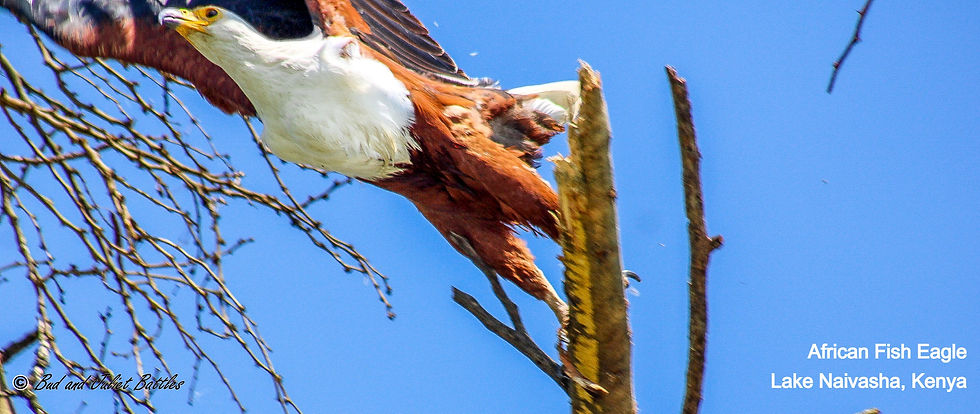
Someday I will...
Someday I will visit there.
Someday I will do that.
Someday I will die wishing it were yesterday...
Someday can be an overused term. A convenient way to set something or someone aside for other priorities. Yet, as the cliche goes, "time still ticks". Tomorrow always seems to be there but then yesterday is too late.
Someday also equates to hope. Hope that tomorrow comes... another chance that our dreams can be realized. For this someday, we will continue to love... continue to laugh... and we will be together again.
Someday the experience of driving Kenya's roads should be made into a video game. A strangely beautiful choreography of chaos and close calls. Yes... Kenya has traffic laws and in some cases traffic signs, however, to most drivers, the rules of the road are merely only guidelines.
Start with the roads... As mentioned in a previous post, roads are built, but never fully completed. Bumps, unfinished sidewalks, and traffic lines leading to a curb are typical for a newly built road. When roads are under construction, it is often a free-for all race to get around in the hopes that it does not become a demolition derby. Other roads are extremely narrow with sharp drop-offs and no shoulders. If there are shoulders along the side of the road, this is only an invitation for drivers to create another lane. Some people remedy this by placing large boulders the size of trash cans creating opportunities for some boda-boda drivers to use them like a skier on a slalom course... an entertaining but nerve-wracking experience... Boda-boda, or piki-piki, is the term for a motorcycle employed to transport people or products. There are tens of thousands of them on the road and paths both in the cities and rural areas. Many boda-bodas are unregistered with drivers that have never had a driver's license. Therefore, it is common for a boda-boda to have two or even three... or four... or five passengers riding on the bike, maybe with a large sack of sweet potatoes and a live chicken... or two. Picture that on a slalom course.
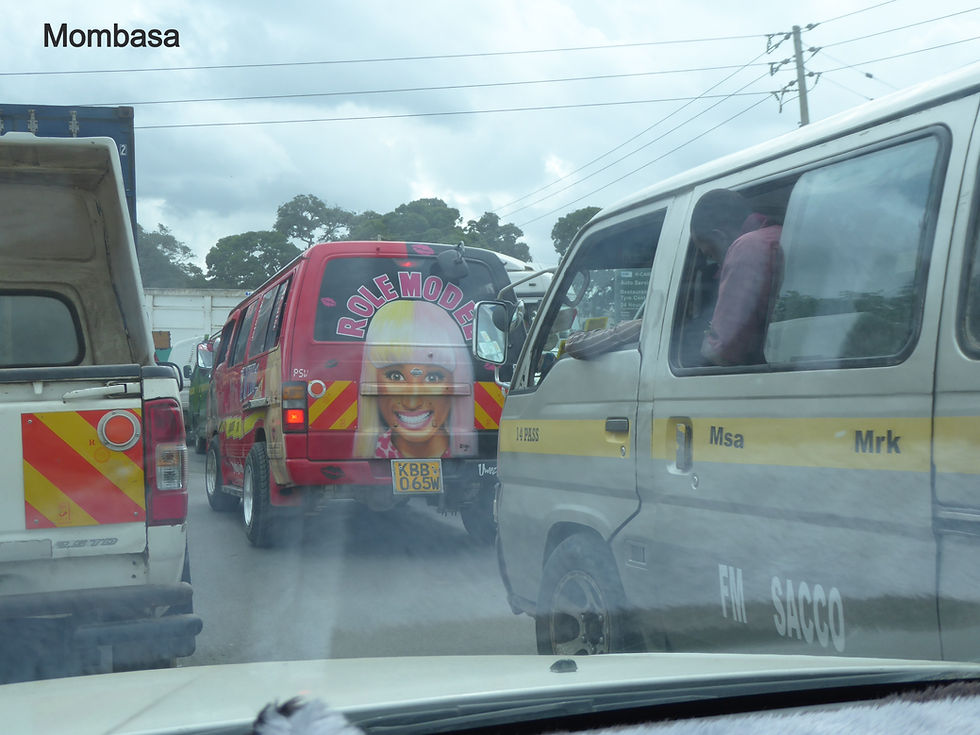
Boda-bodas are often in competition with matatus' and tuk-tuks who have the same lack of road "guidelines" knowledge. Matatus', Kenya's answer to privately owned mini-bus service and tuk-tuk's, a recent import from India, like boda-boda drivers, believe they also own the road. Matatus, being large and intimidating, usually get their way. Usually decorated with spectacular colorful graphics of famous people and symbols from around the world, we often seen images of Tupak, Prince, Michael, Marlyn, Whitney, the Queen Mother and Jesus, among others. I've even seen a tribute to all the Pittsburgh sports teams! They range from rickety old Volkswagen vans to large minibuses blaring loud electronic music to the highest decibels attracting new customers. Conductors, stand in the doorways, half in... half out, screaming above the music urging the next customers to ride their bus, sometimes coercing folks who might have lost their hearing from the noise. One of the unwritten guidelines that you must quickly learn is "never challenge a matatu or lorry (heavy transportation vehicle) ... You will lose..." And if you ride in a Tuk-tuk, which is a glorified golf cart, most often found in the smaller cities, and you crash... "You will lose"...
These motorized modes of transportation, along with political motorcades, broken down water-lorries, donkey-carts, people-powered carts, and of course average personal occupancy vehicles are punctuated by throngs of pedestrians and bicyclists attempting to navigate through the speeding traffic with the hope and prayer that they are not hit. Venders often are found on the streets, selling everything, usually between the cars and matatus near intersections and where road bumps have been placed either by the authorities or individual citizens. Road bumps, built to slow down those not following the guidelines, range in size from a gentle reminder to mountains as treacherous as the road itself... requiring normal ground-clearance vehicles to drive from one side of the road to the other, traversing the bump like a mountain goat on a cliff, to avoid losing an oil pan.
And with all this organized confusion, are the animals... Goats, hogs, and chickens traversing the roads and sidewalks looking for the next meal. The stray dogs and cats. Stray mules and donkeys. The Masai with his herd of cattle crossing busy intersections with no care for time and an acknowledgement that this was once Masai land. We know where we are when stopped on the highway, looking eye to eye at a massive Sanga bovine. It is both amazing and comforting to know this is Kenya... We are home.

Like a driver on Kenya's road, A bird in the forest never seems to wait for someday. Whether on this side of the world or the other, they live and survive for the moment. Into a world that is determined to not see them survive... Yet they are born to survive... to find food and water... to build or find a habitat for safety and shelter... to mate and breed and socialize... and to create the next generation, continuing the beautifully vicious circle of survival.... survival of the fittest.
Many of our photos are of birds in a sedentary moments, perched in a tree or enjoying a pleasant meal or "chat". But excitement intensifies when we are witness to the carnage of a kill, the moment of mating, the playful banter of siblings or the magnificent miracle of flight.

The African Fish Eagle (Haliaeetus vocifer) eats... you guessed it!... fish. Swooping down from the sky or lofty perch, snatching its prey with powerful, clawed talons. Similar to its distant cousin, the North American Bald Eagle, it will also eat other prey such as water birds, lizards, monkeys, and squirrels. Fish Eagles are also scavengers and thieves, gladly taking their meal from other unsuspecting predictors.
Closely related, the White-breasted Cormorant (Phalacrocorax lucidus) is sometimes considered a sub-species to more prolific Great Cormorant of Australia, Asia, Europe, and eastern North America. Exclusive to Africa, some populations only live in freshwater lakes in western Kenya and the Great Rift Valley. Like the African Fish Eagle, these larger birds feed on fish, diving for more than three minutes at a time. Competing with other birds (as well as humans, Crocs, and other animals) for the same meal source, we have watched pairs share their catch with each other.
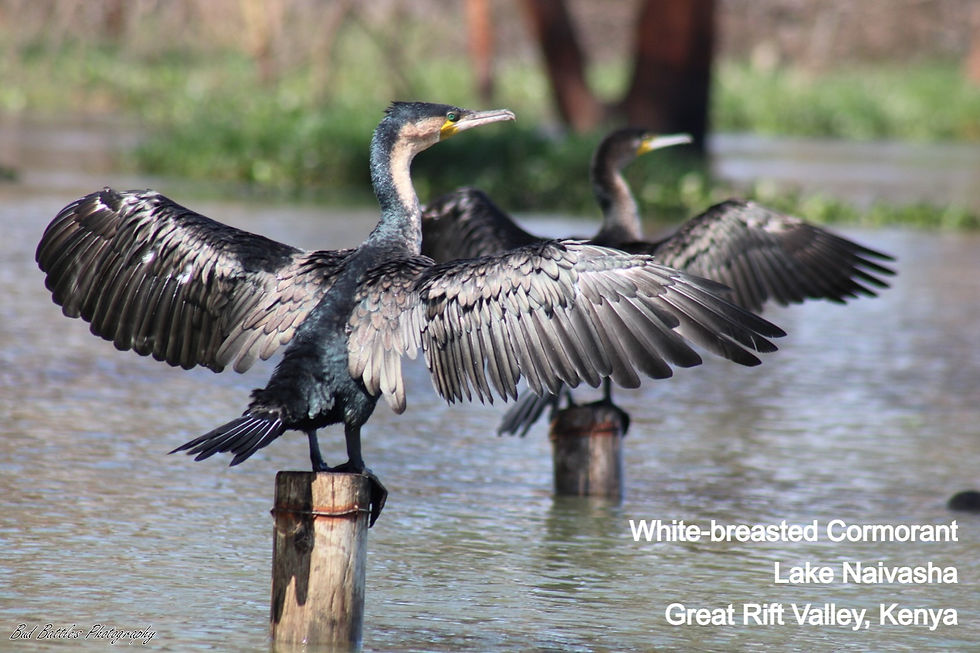
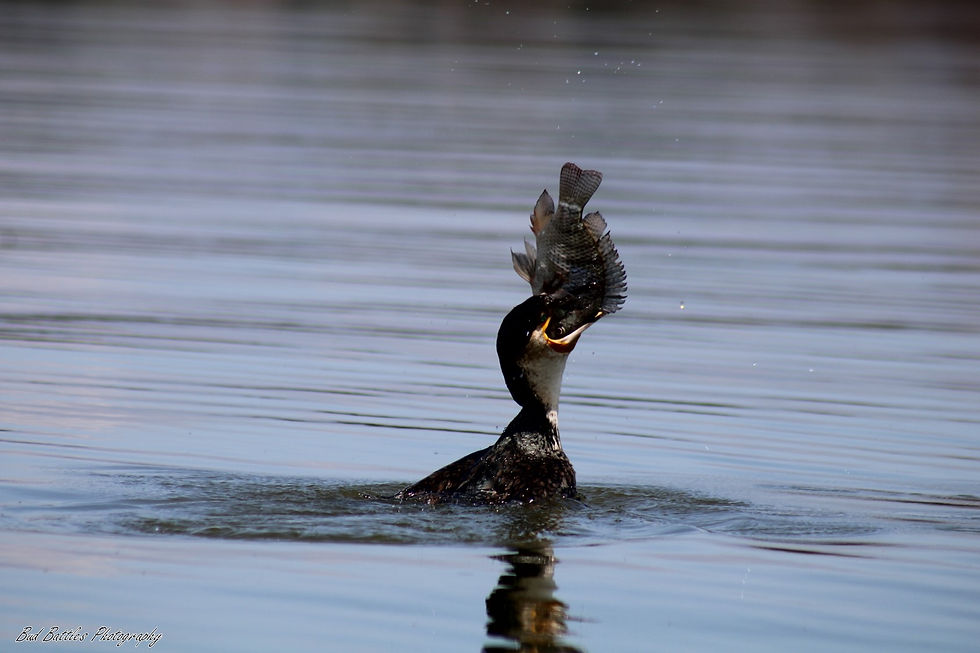
Nature's passage of eat and be eaten has highlighted our experiences no matter where we are in our world... Eagles eat baby crows and jays... Crows and jays attack the eagles, keeping them from nests... but also eat each other's babies if given a chance. One day, walking along Soos Creek Trail in Washington State, Juliet heard a wild commotion behind us. Turning we saw an American Crow (Corvus brachyrhynchos) crow with a baby Steller's Jay ( Cyanocitta stelleri) being chased by an adult jay. As the jay fought, the crow slammed the poor baby against the tarmac. Becoming dinner for that day.
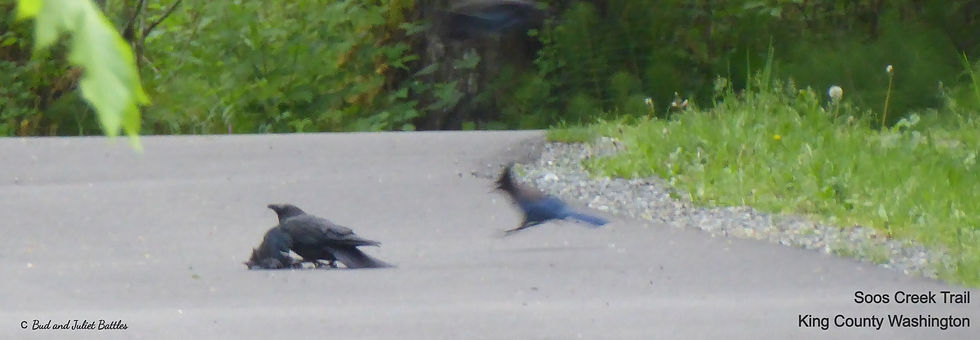
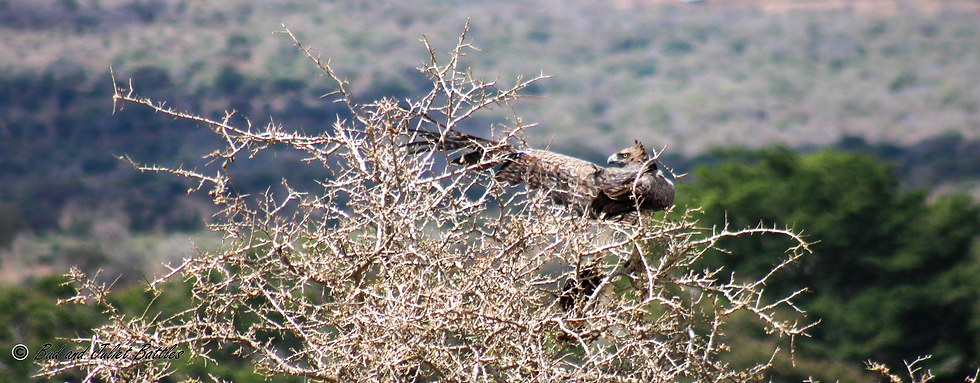
We regularly find birds having birds for dinner... And it's usually not a social event. In Taita Hills, located along the outer shadow of Mount Kilimanjaro, we caught a glimpse of a large raptor grasping a large, feathered bird as it was flying across the arid plain. Seeing that it had perched near the road where we had just been, we quickly turned around.

We found an adult African Crowned Eagle (Stephanoaetus coronatus) with talons deeply embedded into the still moving baby Secretarybird (Sagittarius serpentarius). Two adult secretarybirds, a male and female, were frantically following the scene and then, without confrontation, slowly moved from the area into the distance. Both birds are indigenous to Africa. Considered a Near Threatened species, the territorial Crowned Eagle, specifically found in East Africa, lives in heavily forested regions such as Ngong Road Forest Sancturary in Nairobi, but will occasionally be found in more arid locations such as the Taita Hills. Perched on an Acacia tree, the eagle squeezed life out of the unlucky bird, sometimes repositioning, wings spread wide, as it patiently waited. Dinner was to come later in the evening. An endangered species, Secretarybirds are carnivorous themselves preferring to snack on all species of snake and small vertebrates, prancing in the grasslands, preying with long stick legs as if typing on a typewriter.

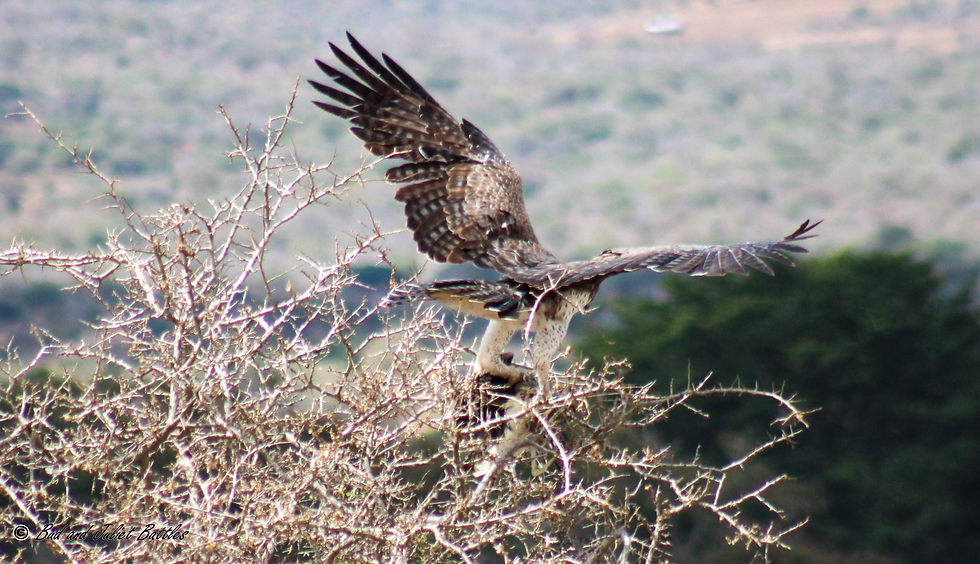
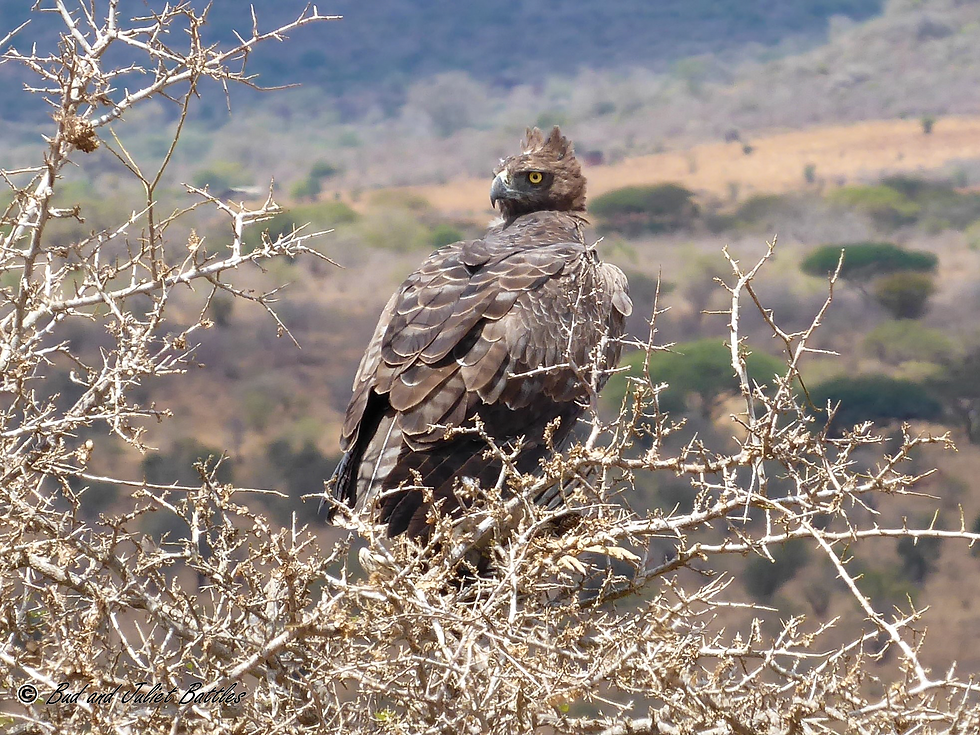
Another predator found in Taita Hills is the African Hawk-eagle (Aquila spilogaster). Although found throughout Sub-Saharan Africa, these birds of prey are often hard to spot, often laying low in the trees of arid savannah woodlands. It's small head with a large beak seemed to be slunk low und an acacia when we first spotted it. Thinking at first it was an injured, juvenile Martial Eagle, we quickly realized as it rose to reveal its powerful legs and a feast below! It was protecting its kill among grazing African Cape Buffalo.
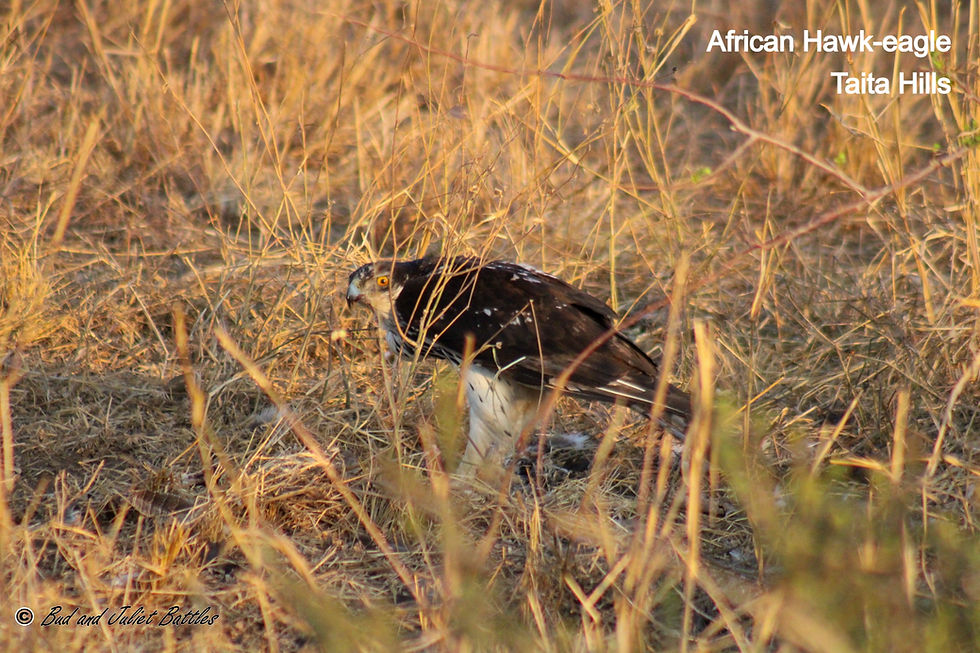

It is difficult to tell African Hawk-eagle males from females, although females tend to be larger with more streaking underneath. These birds are assumed to live 50-60 years and will pair up for life using the same nest year after year after year!
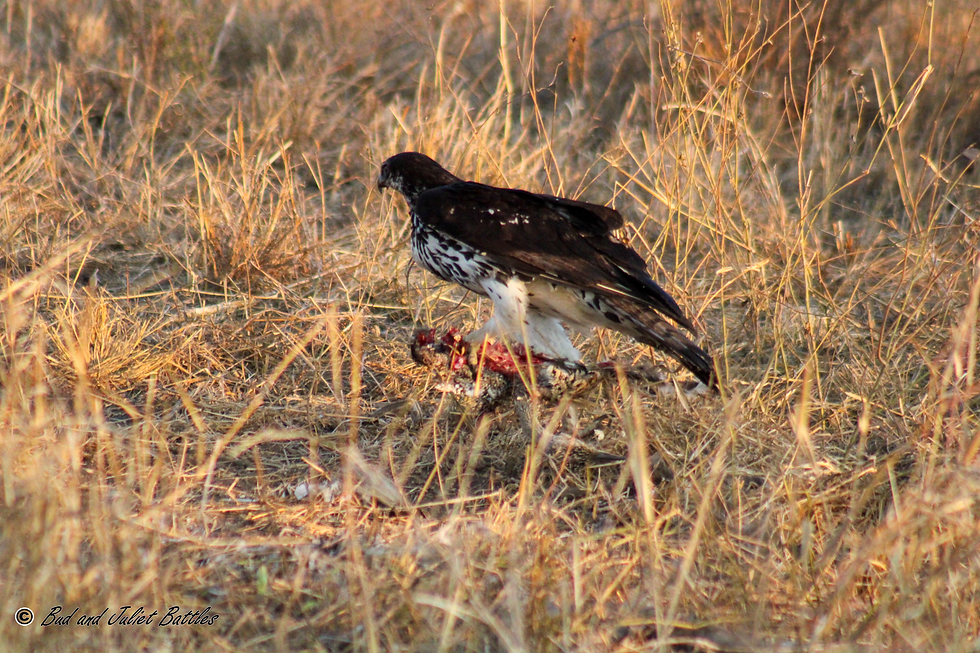
The African Hawk-eagle tend to hunt small to medium sized animals and birds. Becoming slightly agitated by our attention, this adult wanted to move, yet was not interested in leaving its prize behind. With that, we were treated to a remarkable display showing its beautiful plumage and the dinner it was having... a female, Black-bellied Bustard (Lisottis melanogaster). When looking at the face of the bustard, she did not know what hit her.
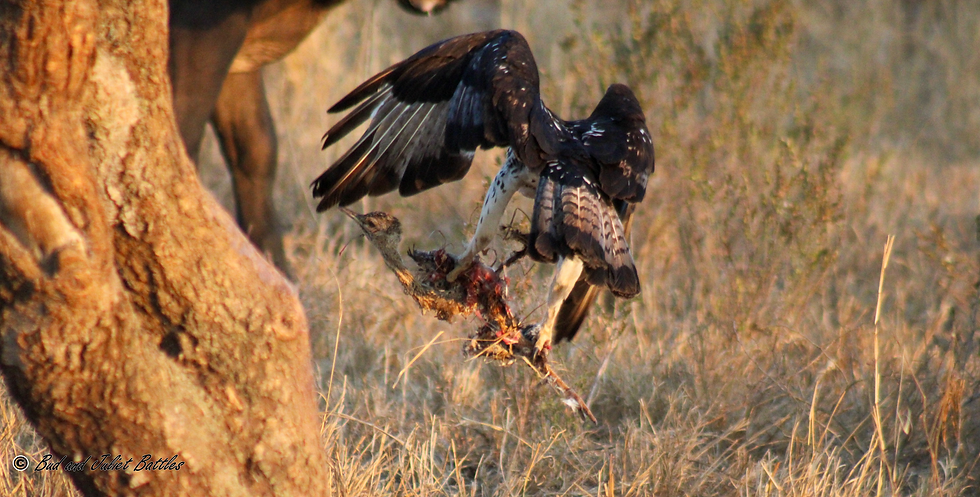

Another great food source found in the ponds, lakes and rice fields of Kenya are reptiles and amphibians. This Great White Egret (Ardea alba) plays with an African Clawed Toad (Xenopus laevis), flipping it, dipping it into the water and flipping it again, before finally devouring it whole. This was in one of many small waterholes during the short rain season in Nairobi National Park.
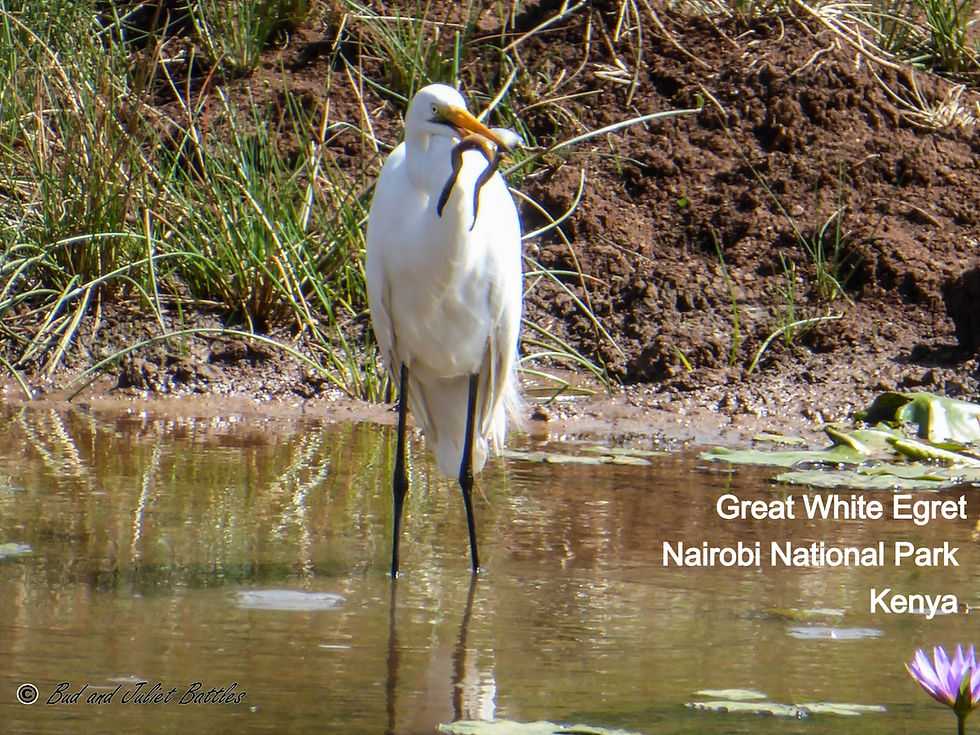

Sometimes I get obsessed with the moment. This occurred when I visited a friend along the rice fields of Ahero in Western Kenya near the city of Kisumu. The Nyando River flows year-round nearby flooding frequently, creating rich fertile soil. It is here that I was able to witness, only ten feet away, a Hamerkop (Scopus umbretta) preying on an African Clawed Toad). Fixated on this bird for over 30 minutes, I took 207 photos of the event... Thank God and technology for digital! The Hamerkop was focused on the same spot for about five minutes...
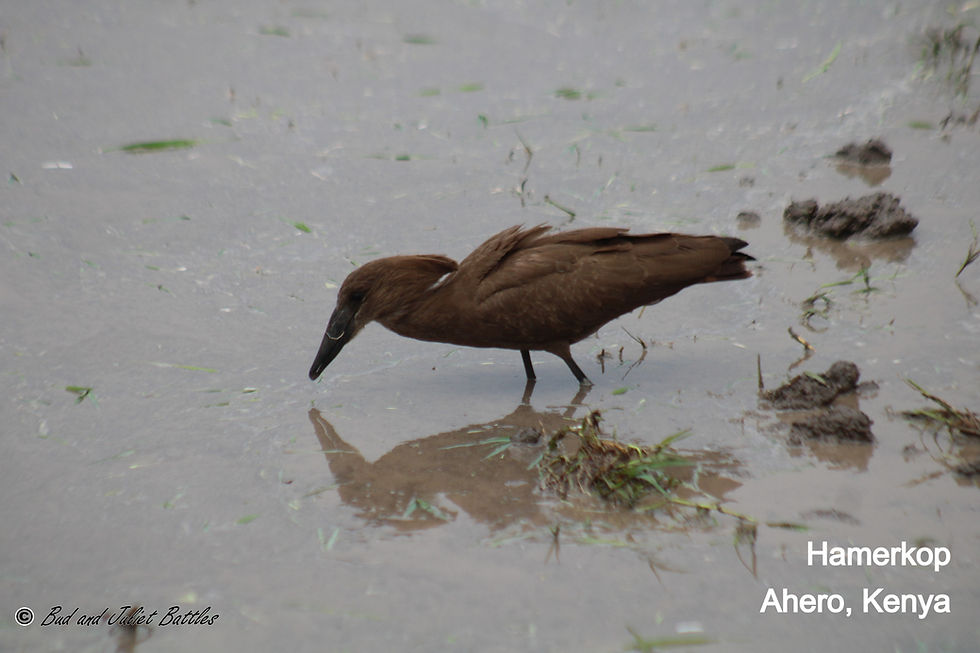
When suddenly its long beak darted into the water pulling a large toad from the flooded rice field....
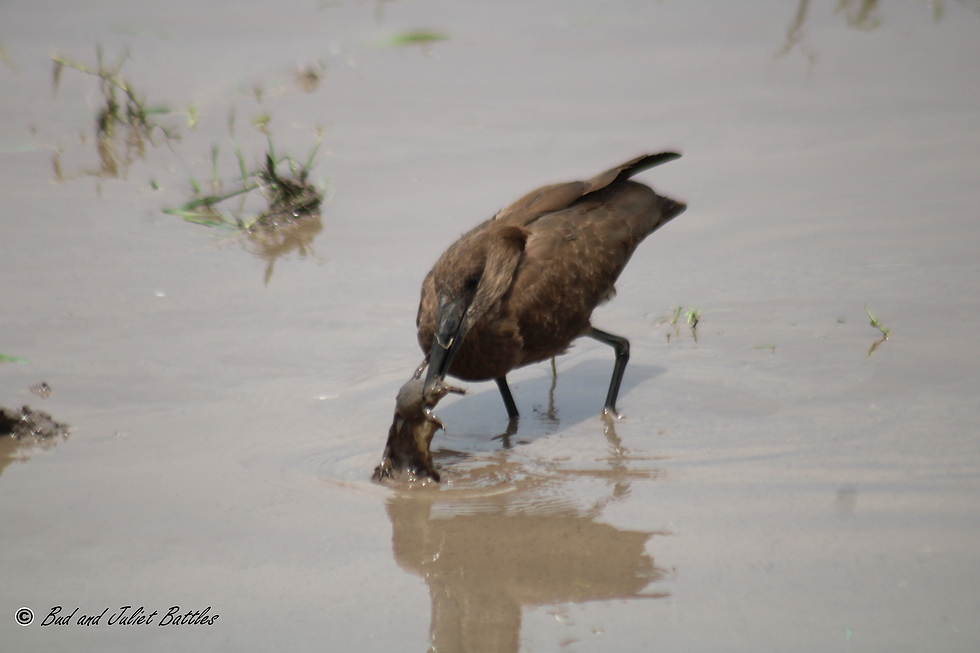
First grasping it tight, dipping the meaty morsel into the water over and over as if it were an appetizer requiring sauce.
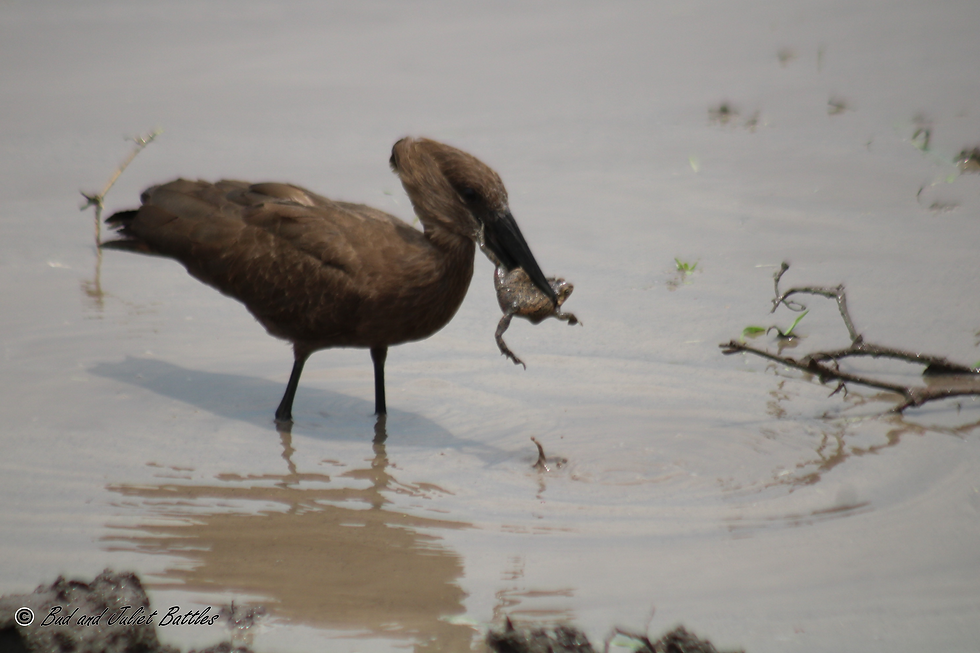
Like the egret, the Hamerkop flipped and tossed the poor amphibian over and over desperate to escape, kicking its strong legs into mid-air without moving an inch from the clutches of its tormentor.
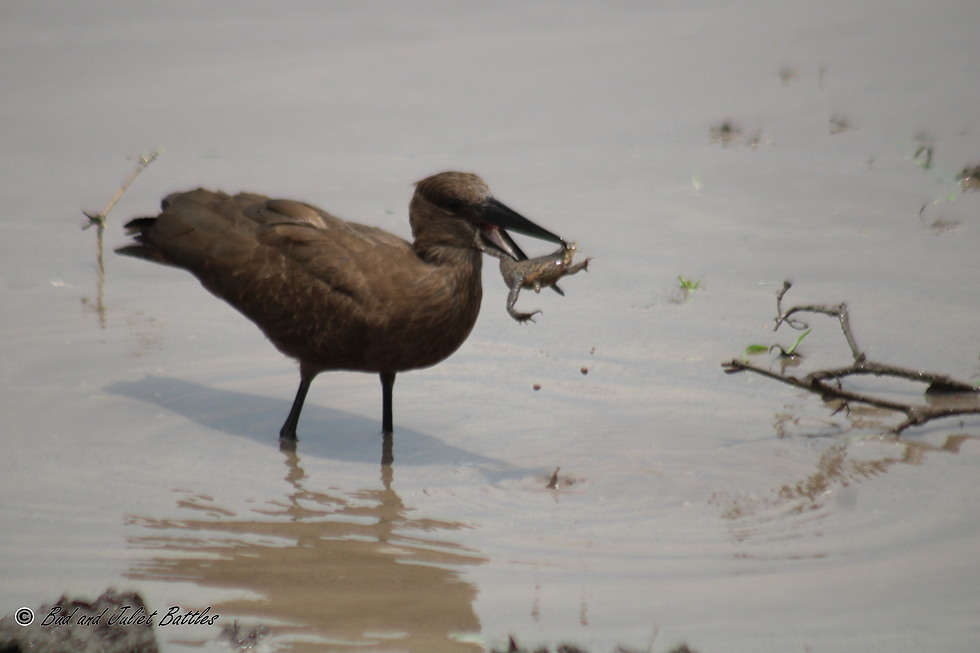
Recognizing that other hamerkops and cattle egrets were suddenly captivated by this enticing show our Hamerkop decides to fly to the next field not far away. Meal in beak...
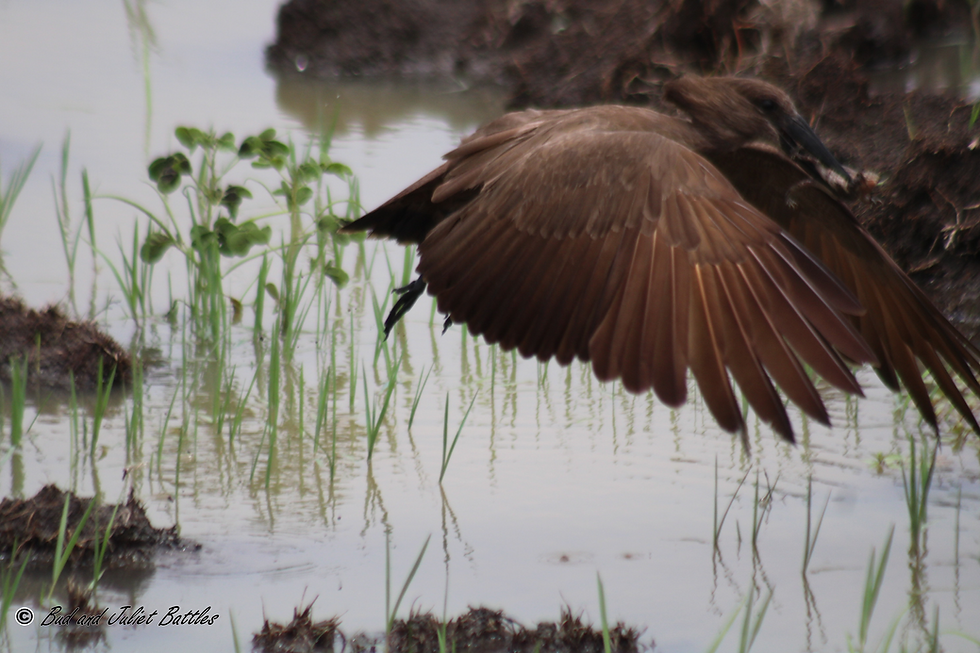
Being tossed, flipped, dipped, and crushed, at this point the toad is either expired or resigned to its fate. On the other hand, the Hamerkop seems quite happy!
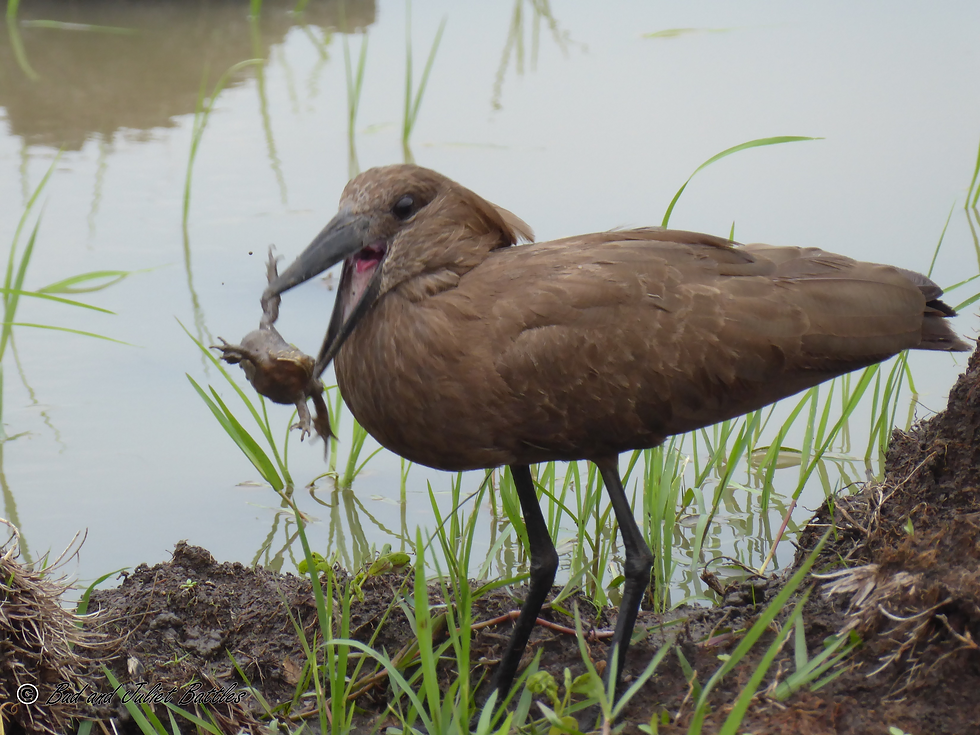

With one more dip and toss, the toad becomes a one gulp meal, thus ensuring that his someday was yesterday...

Today is too short to regret... so, we will make the most of it! When it comes to love, our own love for each other and our love for those around us... We cannot wait for someday. We will cherish the moments and adventures past and present while striving to reach for the possibilities of our unknown future. For someday starts today and tomorrow brings us hope for someday... unless we are eaten... of course.


I so enjoy reading about your adventures and seeing all the photos. You are definitely in the perfect spot at the perfect time to capture it all. Love to you both!
Interesting that you appeared while all of this catch and eat was going on. No release here! Thanks for the life lesson.
😂 207 photos of a hamerkop eating a toad is a bit much- SOMEDAYS!!! :-)😄